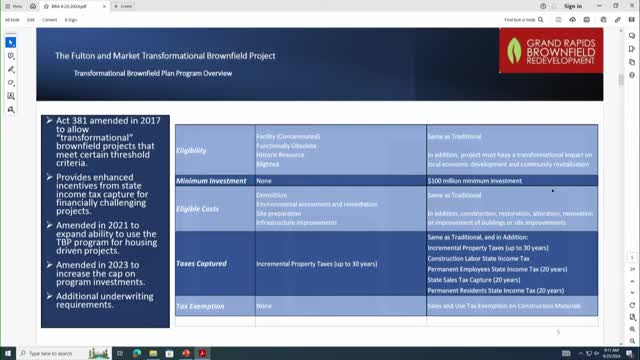Transformational brownfield plans set to reshape communities
September 25, 2024 | Grand Rapids City, Kent County, Michigan
This article was created by AI summarizing key points discussed. AI makes mistakes, so for full details and context, please refer to the video of the full meeting. Please report any errors so we can fix them. Report an error »

In a recent government meeting, officials discussed the future of transformational brownfield plans, emphasizing their significance in community development and economic revitalization. The program, which has been in place since 2017 and is set to sunset in 2027, aims to facilitate redevelopment in previously developed areas, particularly in communities with populations under 225,000.
Key points highlighted included the eligibility criteria for projects, which must demonstrate a transformational impact by integrating residential, office, and hotel spaces in walkable areas. For larger cities like Grand Rapids, a minimum investment of $100 million is required. The meeting also outlined the types of costs that can be reimbursed under the program, including traditional expenses like demolition and infrastructure, as well as construction costs, which have been a recent trend in brownfield tax increment financing (TIF) across the country.
Officials noted that the program allows for multiple revenue streams, including property taxes, income tax capture, and sales tax capture, broadening the financial support available for significant projects. However, it was clarified that funds generated through this program are strictly earmarked for specific developmental purposes and cannot be redirected to other community needs such as childcare or housing.
The discussion also touched on the role of the board in evaluating projects, with assurances that they would have a voice in determining whether a project meets the transformational criteria. The meeting concluded with an invitation for further dialogue among stakeholders, indicating a collaborative approach to future developments.
Key points highlighted included the eligibility criteria for projects, which must demonstrate a transformational impact by integrating residential, office, and hotel spaces in walkable areas. For larger cities like Grand Rapids, a minimum investment of $100 million is required. The meeting also outlined the types of costs that can be reimbursed under the program, including traditional expenses like demolition and infrastructure, as well as construction costs, which have been a recent trend in brownfield tax increment financing (TIF) across the country.
Officials noted that the program allows for multiple revenue streams, including property taxes, income tax capture, and sales tax capture, broadening the financial support available for significant projects. However, it was clarified that funds generated through this program are strictly earmarked for specific developmental purposes and cannot be redirected to other community needs such as childcare or housing.
The discussion also touched on the role of the board in evaluating projects, with assurances that they would have a voice in determining whether a project meets the transformational criteria. The meeting concluded with an invitation for further dialogue among stakeholders, indicating a collaborative approach to future developments.
View full meeting
This article is based on a recent meeting—watch the full video and explore the complete transcript for deeper insights into the discussion.
View full meeting
